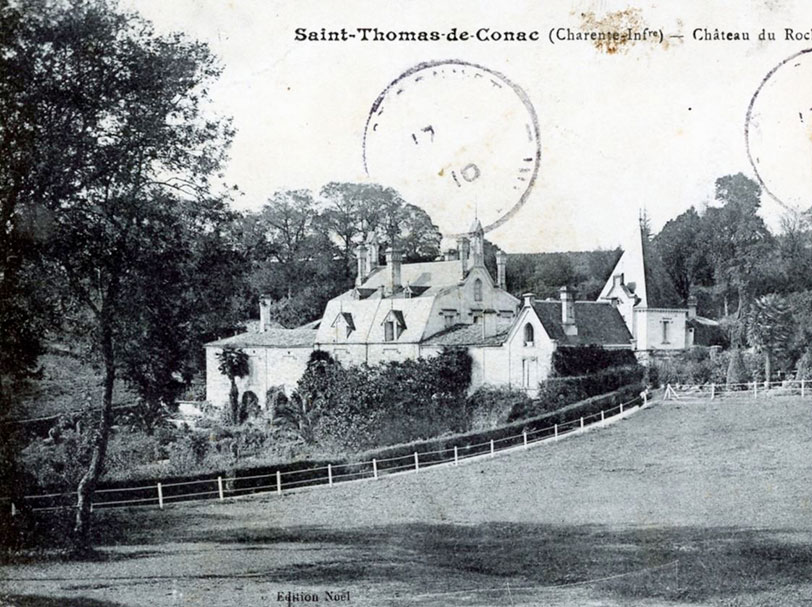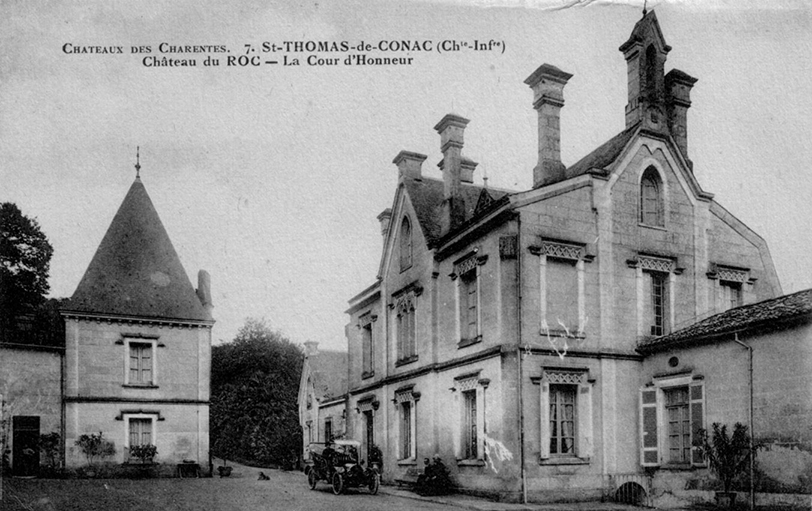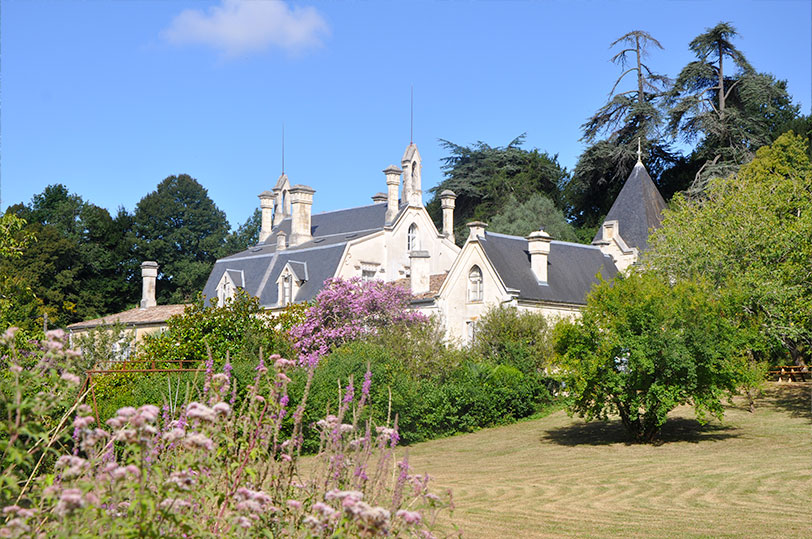A little bit of history
Source : https://inventaire.nouvelle-aquitaine.fr/dossier/chateau-du-roc/f6bd47be-3196-4a85-acbc-a56838a8aad0 - General inventory of the cultural heritage of new Aquitaine – Château du Roc
The Domaine du Roc was mentioned for the first time in 1646 when a decision of the Parliament of Bordeaux awarded it to Gédéon Mussaud de Touvenac. His daughter, Louise, wife of François Néraud de Langlade, seneschal of the county of Cônac, bequeathed it to his daughter Jeanne who brought it by marriage, in 1702, to Jacques Laplanche (1673-1713), lord of Artillac and the Chapelle, also seneschal of the county of Cônac. Their son, Jacques Michel Laplanche (1704-1760), Lord of the Chapel, passed on the Roc to his son, Fleurimond Laplanche (1754-1831) who owned it during the Revolution. At that time, the estate was in poor condition. Riddled with gambling debts, Fleurimond Laplanche had to sell the Roc in 1818, while retaining the usufruct until his death.

The buyer is a cousin of his father's second wife, Léger-Romain Dejean (1770-1848). After him, the estate passed to his son, Edme Jérémie Dejean (1800-1883) who undertook to modernize it (it is to him that we owe the construction of the 19th century parts of the castle, in 1866). His sons-in-law, Paul Regnauld and Louis de La Rochetolay, polytechnic engineers, redesigned the park. Le Roc then became the property of Edmond Regnauld (1858-1946), son of Paul, mayor of Saint-Thomas from 1908 to 1919, then of his son-in-law, General Marcel Sciard (1881-1967).
The site presents rare elements that seem to date from the end of the Middle Ages. This is the case of the access door to the galleries dug under the rock, located at the foot of the cliff. The sculpted lintel in accolade and network, with crest at the initial D like Dejean, was probably made in the 19th century, perhaps by copying an older lintel: the curve of the accolade, not flattened enough on the sides and tapered at its top, does not indeed plead for a dating of the 15th century or the 16th. On the other hand, the jambs of the door show the remains of moldings which can be traced back to this period.
The Château du Roc appears on the cadastral plan of 1818. This document mentions the galleries under the rock, the accommodation or "quarryman's house", the stables, the castle itself, a slender building, as well as the park crossed by a course of water, and the smallholding to the south. A pond stood near the entrance to the castle.
The castle itself comprises three parts, from three different periods: a basement, probably medieval, with a buttress and thick walls widening at the base, and sheltering vaulted cellars; the lowest part of the castle, with its wide openings with protruding support and its adjoining rooms, seems to date from the 18th century but had to replace an older construction; on this complex was grafted in 1866 and 1874, according to the cadastre, a higher body of building, of neo-medieval style, under a high slate roof, while the decoration of the old part (stacks of chimneys, drips of the windows) was brought up to date. It was probably at the same time that the "quarryman's house" was extended to the south with the addition of a one-storey pavilion covered with slate, also of medieval inspiration. Finally, it was during this same period that the accesses to the galleries under the rock were decorated with new neo-medieval sculptures marked with the initial D of the Dejeans.
Among the buildings of the smallholding, those visible to the south of the courtyard were built in the 19th century since they do not appear on the cadastral plan of 1818. Among those located to the north, placed according to the same layout as in 1818, some had to be rebuilt later. The cadastre also indicates a new construction at this location in 1886. The sharecropper's dwelling, at the right end, with its small openings arranged in no particular order, could date from the 18th century.

Source : : http://www.chateau-fort-manoir-chateau.eu/chateaux-charente-maritime-chateau-a-st-thomas-du-roc.html - Château du Roc à Saint Thomas de Conac
The known history of this land is relatively recent, but the presence of architectural elements dating back to the 15th century testifies to an ancient occupation of the site. We know that the Domaine du Roc had been awarded by order of the parliament of Bordeaux, in 1646, to Gédéon Mussaud de Touvenac. After the death of Gédéon Mussaud, Le Roc passed on to his daughter Louise, widow of François Néraud de Langlade. Following a division passed in 1702, the domain "consisting of a house, barns, chaye, winch and cellars which are there, fuye, and other buildings" fell to his daughter Jeanne Néraud de Langlade who married shortly after Jacques Laplanche, Lord of Artillac.
The Laplanches kept Le Roc until 1818. On that date, Léger Dejean bought the estate and its outbuildings from Fleurimont Laplanche. An amusing poster from this period describes the property of the Roc as "a beautiful house with all its most convenient easements, barnyard, large, beautiful and good garden, superb fountain, well-populated leak, excellent reservoir, cellars, water boilers -of life". It is specified that "as the furnishing of a house as beautiful as it is vast usually becomes very expensive, whoever intends to become a buyer can also buy furniture that is his own and appropriate". It was even pointed out that the apartments were regular and well distributed, that the view from the house extended over the Gironde and that its architecture is solid, having as its base an admirable vault. Finally, it is mentioned that it "would be easy, with little expense, to carry water through channels to all the rooms of the house and to form there baths as flattering as they are salutary". And to conclude that after "the richest description, the eye of the connoisseur would still be amazed at the dryness of the painter, or rather at the beauty of nature, the most perfect eloquence could only weakly express it" .
By marriage the property passed to the Horric family of La Rochetolay, when Louise Dejean, sister of General Edme-Napoléon Dejean, member of the Superior Council of the Artillery, Commander of the Legion of Honor, married in 1850 Louis-Marc-Stanislas Horric, Count of La Rochetolay. This character, born in 1817 in Barbezieux, entered the service of the State in 1840 after being admitted to the École Polytechnique in 1836 and to that of Ponts-et-Chaussées in 1838. From 1845, he directed the construction of the railway from Tours to Bordeaux, then served as chief engineer and general manager of construction works at the Compagnie du Midi. Once again a civil servant, in 1868 he was put in charge of the maritime service of the department of Gironde. Having become inspector general of the Ponts-et-Chaussées, he retired in 1881 and died that same year at the Château du Roc. His son, Louis Horric, Count of La Rochetolay inherited the property where he lived. Last male representative of a branch separated in 1464 from the old Angoumoise, Poitevine and Saintongeaise house of Horric, he died in 1900. The Château du Roc became, around 1925, the property of the Régnauld family by marriage. The Gothic-inspired building seems to have been built in the second half of the 19th century on the long mansion over cellars, described in 1818. It consists of a main building on two levels covered with a roof in slate from which rise tall chimneys. The windows are decorated with back bands. The building was built on old foundations dating back perhaps to the 15th century, as evidenced by the few doors decorated with intersecting moldings giving access to the troglodyte cellars.
Today, the Castle
The estate is now held by Hughes & Joëlle Sciard, who perpetuate a family history that began almost two centuries ago. Its alley of bicentenary plane trees, opening onto the main courtyard, form the authentic character of this beautiful traditional French residence, where you will be welcomed with simplicity and warmth.
